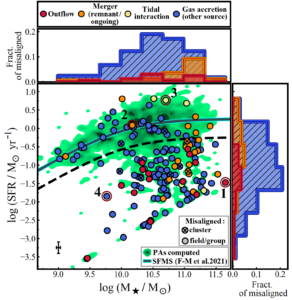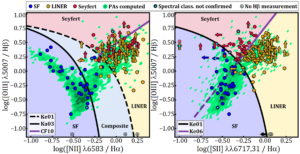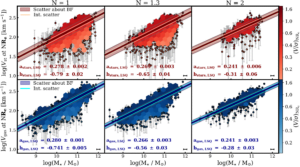I am a Ph.D. student working with Prof. Luca Cortese, Dr. Brent Groves and Dr. Amelia Fraser-McKelvie.
My research focus is in the field of extragalactic Astronomy. I study the kinematics of stars and gas in galaxies from the Nearby Universe using Integral-Field Spectroscopic (IFS) data from the SAMI and MaNGA surveys. I am particularly interested in the differences between the rotation of stars and gas as a probe of the processes that shape galaxies throughout their evolution.
Publications:
First Author:
Contributing Author:
Social Media:
My first PhD project focused on the kinematic misalignments between the rotation of stars and gas in the SAMI Galaxy Survey.
Check out the paper on this topic published in MNRAS:
Also have a look at my talks on this topic at ASA ASM 2022 and the ASTRO 3D Science Meeting 2022:
ASTRO 3D 2022:
ASA ASM 2022:
In summary:
- I identified a sample of 169 misaligned galaxies from a total of 1445 galaxies with stellar and gas rotation;
- By combining the spectral properties of misaligned galaxies with their misalignment angle measurement and optical morphology, i identified the most probable physical cause of the kinematic misalignment (see image below; Fig. 6 of paper above);

Fig. 1 Causes of kinematic misalignments in the SAMI Galaxy Survey (DR3) shown on the stellar mass-SFR plane.
- The majority of misaligned galaxies have a Low-Ionisation Nuclear Emission Line region (61%) ; 22% have ionisation dominated by star formation while 17% have a significant AGN component (Seyfert objects). For misalignments driven by accretion, the new gas is not feeding new star formation in most cases;

Fig. 2 Spectral classification of misaligned galaxies in SAMI DR3 from the [NII] and [SII] BPT diagrams
- Misaligned galaxies typically have higher Sérsic indices and lower sSFR & stellar spin than appropriately-matched samples of aligned galaxies. This is indicative of the fact that misaligned gas takes longer to precess into a stable configuration in early-type/gas poor galaxies.
My second PhD project focused on constructing a sample with stellar and gas kinematics from the MaNGA Galaxy Survey. This sample includes galaxies across a wide spectrum of kinematic morphologies. Using this sample, I compute the Tully-Fisher (TF) relation for stellar and gas rotation.
I provide a quantification of how the TF changes at different radii and discuss whether stars and gas are found in statistical different states of dynamical equilibrium at different radii. I found that the two baryonic components have statistically different states of dynamical equilibrium in the inner parts (<1.3 half-light radii), but are dynamically coupled in the outer edges (at 2 half-light radii).
I also analyse the physical causes of scatter in the TF. No correlation was found between TF scatter and: optical morphology, star formation rate density, signs of recent gas accretion, the presence of kinematic features (bars and rings) and environment (field vs group). The TF scatter strongly correlates with kinematic morphology. This result suggesting that the effect of mergers spinning down galaxies is the dominant factor causing galaxies to scatter off the TF.

Fig. 3: The TF relation from SDSS-MaNGA for stellar (top) and gas (bottom) rotation at different radii, coloured by the rotation-to-dispersion ratio.
Check out the paper on this topic published in MNRAS:
Also check out my talk on this topic at the ASA ASM 2023:
ICRAR Statement
The content of this page is maintained by Andrei Ristea, please contact them with any questions or comments on this content.